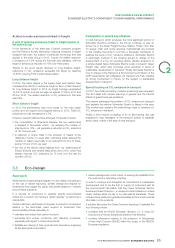APC 2012 Annual Report Download - page 68
Download and view the complete annual report
Please find page 68 of the 2012 APC annual report below. You can navigate through the pages in the report by either clicking on the pages listed below, or by using the keyword search tool below to find specific information within the annual report.
2012 REGISTRATION DOCUMENT SCHNEIDER ELECTRIC66
SUSTAINABLE DEVELOPMENT
2SCHNEIDER ELECTRIC’S COMMITMENT TO ENVIRONMENTAL PERFORMANCE
•has a Product Environmental Profi le (PEP) providing a list
of materials, a recycling rate and a calculation of eleven
environmental impacts such as raw material and energy
consumption, carbon footprint and damage to the ozone layer;
this environmental profi le is established over the whole product
life cycle, from manufacture to end of working life;
•contains a guide identifying and locating the subsets or
components required for a particular recycling process, called
the End-of-Life Instruction (EoLI).
As part of its new Connect business program, Schneider Electric
is strengthening its eco-brand Green Premium and renewing its
communication through the Planet&Society Barometer.
Green Premium is the foundation of Schneider Electric’s Eco-design
approach. Through knowledge of the substances in its offerings
and evaluation of environmental impacts, Green Premium allows
Schneider Electric to target and engage improvements in the
environmental footprint of its future offerings. Compliance to Green
Premium criteria also contribute to the conservation of biodiversity.
Action plans
Green Premium Eco-brand
The Schneider Electric Environment Marketing campaign was rolled
out during2012, promoting the Green Premium eco-brand through:
•the Schneider Electric electronic catalogue: the Green Premium
offerings are clearly identifi ed and environmental information is
collected appropriately;
•direct access from the Schneider Electric web portal: the Green
Premium web pages explain in detail Schneider Electric’s
approach and each environmental criterion addressed by
GreenPremium;
•a single “Check a Green Premium Product” web portal: RoHS
compliance information, REACH content (SVHC - “Substance
of Very High Concern”), Product Environmental Profi le and End-
of-Life Instruction are available on simple request regarding the
trade references of Schneider Electric. This information can also
be downloaded ;
•publication of the Green Premium white paper.
In 2012, more than 230 Product Environmental Profi le (PEP)
documents and more than 130 End-Of-Life Instructions (EoLI)
were generated in addition to the hundreds of documents already
available.
Linked to more than 75% of revenue taken for the RoHS compliant
offers and with the REACH information available, Schneider Electric’s
target was to consolidate this in2012 with 65.5% of global product
sales made through Green Premium offers, based on 2011 sales.
The Check a Product website was checked worldwide on average
more than 3,000times per month and more than 6,000reference
products were checked monthly for their RoHS and REACH
environmental status and their PEP and EoLI environmental
information.
As part of the development of new Schneider Electric offerings,
Green Premium is an integral part of the creation and development
process for Schneider Electric’s offers as a critical deliverable for
marketing product offers.
Substance Management
Schneider Electric is subject to European environmental regulation,
with particular emphasis on the use of toxic substances.
The REACH regulation requires traceability of dangerous substances
and the RoHS directive requires elimination of six substances:
lead, mercury, cadmium, hexavalent chromium, polybrominated
biphenyls (PBBs) and polybrominated diphenyl ethers (PBDE).
Schneider Electric has implemented the RoHS and REACH
programs by applying these European regulations.
The RoHS program, started in 2006, aims to eliminate the six
substances from all products. By deciding to eliminate these
substances from all its products, whether or not affected by the
directive or sold on the European market or worldwide, Schneider
Electric has gone far beyond the directive’s requirements.
Efforts to bring products into compliance continued in 2012,
particularly for the new entities to have recently joined Schneider
Electric. For specifi c offers that have little to do with the scope of the
RoHS directive, such as the medium voltage equipment of Areva
Distribution activities, RoHS compliance will be continued during
the years to come. Any new offer is developed in compliance with
the RoHS directive.
Directives similar to the RoHS European directive are now in force or
being discussed in several countries. Schneider Electric’s decision
to generalize the application of the RoHS to all its products has
helped anticipate developments in regulations all over the world
and Schneider Electric is able to offer products which comply with
the RoHS directives on all its markets (China, India, South Korea,
Japan, etc.).
The REACH program, initiated in2008, aims not only to ensure
that substances used by Schneider Electric and its subsidiaries
are registered and authorized for the applications in question, in
accordance with regulations, but also to specify the information
to be provided to customers about the presence and level of
Substances of Very High Concern in Schneider Electric products.
In2012, the REACH program continued to take into consideration
the updates to the list of Substances of Very High Concern
published by the European Chemicals Agency (ECHA). At the
end of November 2012, the communication of the presence and
content of these substances included 84 hazardous substances.
The CRESCENDO project, initiated in 2011, which aims to
integrate substance management within our information systems,
was fi nalized in2012 for implementation in2013. The automation
of REACH and RoHS reports will accelerate the dissemination
of information to our customers while anticipating the impact of
obsolescence on our offerings.
Environmental information
The Green Premium eco-brand guarantees customers the
availability of environmental information relating to Schneider
Electric product offers such as the Product Environmental Profi le
(PEP) or the End-of-Life Instruction (EoLI).
























